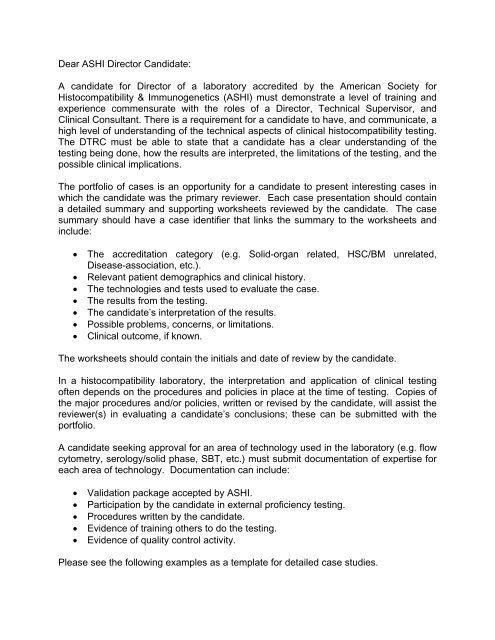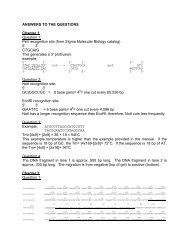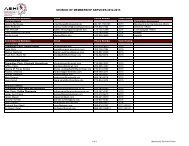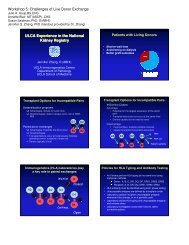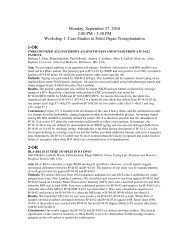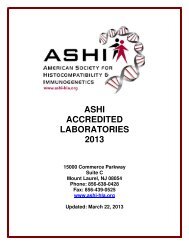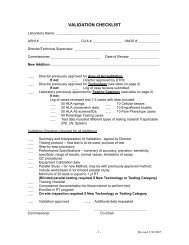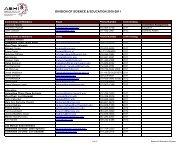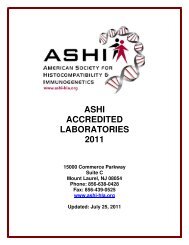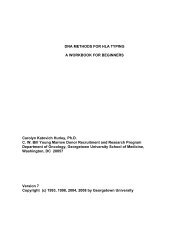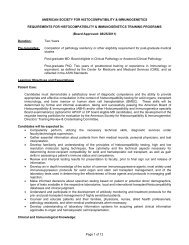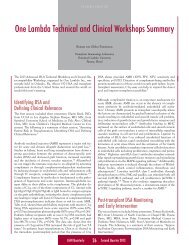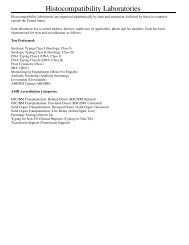Sample case file - American Society for Histocompatibility and ...
Sample case file - American Society for Histocompatibility and ...
Sample case file - American Society for Histocompatibility and ...
You also want an ePaper? Increase the reach of your titles
YUMPU automatically turns print PDFs into web optimized ePapers that Google loves.
Dear ASHI Director C<strong>and</strong>idate:<br />
A c<strong>and</strong>idate <strong>for</strong> Director of a laboratory accredited by the <strong>American</strong> <strong>Society</strong> <strong>for</strong><br />
<strong>Histocompatibility</strong> & Immunogenetics (ASHI) must demonstrate a level of training <strong>and</strong><br />
experience commensurate with the roles of a Director, Technical Supervisor, <strong>and</strong><br />
Clinical Consultant. There is a requirement <strong>for</strong> a c<strong>and</strong>idate to have, <strong>and</strong> communicate, a<br />
high level of underst<strong>and</strong>ing of the technical aspects of clinical histocompatibility testing.<br />
The DTRC must be able to state that a c<strong>and</strong>idate has a clear underst<strong>and</strong>ing of the<br />
testing being done, how the results are interpreted, the limitations of the testing, <strong>and</strong> the<br />
possible clinical implications.<br />
The portfolio of <strong>case</strong>s is an opportunity <strong>for</strong> a c<strong>and</strong>idate to present interesting <strong>case</strong>s in<br />
which the c<strong>and</strong>idate was the primary reviewer. Each <strong>case</strong> presentation should contain<br />
a detailed summary <strong>and</strong> supporting worksheets reviewed by the c<strong>and</strong>idate. The <strong>case</strong><br />
summary should have a <strong>case</strong> identifier that links the summary to the worksheets <strong>and</strong><br />
include:<br />
<br />
<br />
<br />
<br />
<br />
<br />
<br />
The accreditation category (e.g. Solid-organ related, HSC/BM unrelated,<br />
Disease-association, etc.).<br />
Relevant patient demographics <strong>and</strong> clinical history.<br />
The technologies <strong>and</strong> tests used to evaluate the <strong>case</strong>.<br />
The results from the testing.<br />
The c<strong>and</strong>idate’s interpretation of the results.<br />
Possible problems, concerns, or limitations.<br />
Clinical outcome, if known.<br />
The worksheets should contain the initials <strong>and</strong> date of review by the c<strong>and</strong>idate.<br />
In a histocompatibility laboratory, the interpretation <strong>and</strong> application of clinical testing<br />
often depends on the procedures <strong>and</strong> policies in place at the time of testing. Copies of<br />
the major procedures <strong>and</strong>/or policies, written or revised by the c<strong>and</strong>idate, will assist the<br />
reviewer(s) in evaluating a c<strong>and</strong>idate’s conclusions; these can be submitted with the<br />
portfolio.<br />
A c<strong>and</strong>idate seeking approval <strong>for</strong> an area of technology used in the laboratory (e.g. flow<br />
cytometry, serology/solid phase, SBT, etc.) must submit documentation of expertise <strong>for</strong><br />
each area of technology. Documentation can include:<br />
<br />
<br />
<br />
<br />
<br />
Validation package accepted by ASHI.<br />
Participation by the c<strong>and</strong>idate in external proficiency testing.<br />
Procedures written by the c<strong>and</strong>idate.<br />
Evidence of training others to do the testing.<br />
Evidence of quality control activity.<br />
Please see the following examples as a template <strong>for</strong> detailed <strong>case</strong> studies.
1<br />
CASE PORTFOLIO FILE FOR HISTOCOMPATIBILITY (HLA)<br />
LABORATORY DIRECTOR TRAINING AND QUALIFICATION<br />
Manish J. G<strong>and</strong>hi, MD<br />
Mayo Clinic<br />
Rochester, MN 55905<br />
Case Number:<br />
# 4.5 patient RJ869<br />
Category or Type of Case:<br />
# 4 Solid Organ-Live Donor<br />
Blood Group:<br />
Recipient: B Rh positive<br />
Donor: O Rh positive<br />
Ethnicity: Asian, native of Philippine<br />
Gender: Female<br />
Organ type: Kidney<br />
Technology(ies)/Test(s) Used:<br />
<br />
<br />
<br />
<br />
<br />
HLA typing SSP<br />
HLA typing r-SSO<br />
Flow cytometry T <strong>and</strong> B cell crossmatches<br />
T-cell CDC-AHG crossmatch<br />
Single antigen Bead (SAB) testing <strong>for</strong> antibodies to HLA Class I <strong>and</strong> II<br />
Diagnosis:<br />
End-stage renal disease secondary to AL amyloidosis status post renal transplant in 1988<br />
<strong>and</strong> status post autologous stem cell transplant in 2006 <strong>and</strong> 2008.<br />
Clinical History:<br />
This is a 51-year-old female with a history of AL amyloidosis that developed after living<br />
related donor kidney transplantation. She received a living donor kidney transplant from<br />
her brother in 1988 in Saudi Arabia <strong>for</strong> end-stage renal disease of unclear etiology. She<br />
did well with this kidney until March, 2005 when she developed allograft pyelonephritis.<br />
After treatment with antibiotics, her renal function failed to recover, <strong>and</strong> a renal biopsy
2<br />
showed AL amyloidosis with lambda light chain staining. She underwent an autologous<br />
stem cell transplant on March 3, 2006. Despite what appears to be a complete<br />
hematologic response, her renal allograft function started to decline. Repeat biopsy<br />
showed only amyloidosis without any evidence of rejection. Kidney transplant<br />
evaluation was initiated. She then went on to dialysis in February, 2008. She received<br />
her second peripheral stem cell transplant in August, 2008 <strong>and</strong> appears to be in remission.<br />
Her medical history is also significant <strong>for</strong> chronic hepatitis B <strong>and</strong> C. These two<br />
infections appear to have occurred following her first kidney transplant.<br />
Due to a positive crossmatch with her potential donor, her daughter, she was evaluated to<br />
undergo a paired exchange transplant. She received her transplant on 8/14/09 from<br />
donor-3. This donor is same as donor-8 from <strong>case</strong> #4.4. Her daughter (donor-2) is the<br />
same as donor-9 from <strong>case</strong>#4.4 <strong>and</strong> she donated her kidney to recipient MB916.<br />
Sensitization History:<br />
Previous transplant<br />
Pregnancy<br />
Multiple blood transfusions<br />
Tests Per<strong>for</strong>med<br />
HLA-typing low resolution by SSP<br />
HLA-typing low to medium resolution by r-SSO<br />
SAB testing on Luminex plat<strong>for</strong>m <strong>for</strong> antibodies to HLA Class I <strong>and</strong> II<br />
Flow cytometric crossmatch: T <strong>and</strong> B Cell<br />
T cell AHG-CDC crossmatch<br />
Results of Evaluation <strong>and</strong> Testing:<br />
First Kidney Transplant per<strong>for</strong>med in 1988<br />
Patient received kidney transplant from her brother in 1988. This was per<strong>for</strong>med in<br />
Saudi Arabia. No records are available <strong>for</strong> review. Patient was not sure of the exact<br />
institution <strong>and</strong> thus no additional in<strong>for</strong>mation can be obtained.<br />
Second Transplant:<br />
Summary of Donors Evaluated:<br />
Total Number of Donors Evaluated: Three<br />
HLA typing per<strong>for</strong>med on all three donors.<br />
Evaluation crossmatch per<strong>for</strong>med on 2/3 donors.<br />
Evaluation crossmatch includes: T-cell AHG-CDC, T-cell FXM <strong>and</strong> B-cell FXM<br />
Final <strong>and</strong> post transplant crossmatch includes: T-cell FXM <strong>and</strong> B-cell FXM<br />
Donor selected to provide kidney: Donor-3<br />
Donor-3 was part of the first paired donor exchange program within our<br />
institution<br />
All HLA-typing <strong>and</strong> crossmatch results are summarized on page # 1. Pertinent<br />
results are discussed next.
3<br />
Donor-1<br />
HLA typing<br />
Results are summarized below. Worksheets are page # 66-69.<br />
Donor-1 is the niece <strong>and</strong> is a 3/6 antigen mismatch at HLA-A, B <strong>and</strong> DR.<br />
Comments:<br />
Donor types as HLA-B55, 75. HLA-B75 is uncommon in the Caucasian population but<br />
its frequency ranks #10 in the Asian (API) group in US population. Donor is of Asian<br />
ethnicity.<br />
Crossmatch<br />
Donor not available <strong>and</strong> thus not per<strong>for</strong>med.<br />
Comments:<br />
Recipient SAB demonstrates rising anti-HLA-A24 since April, 2008. SAB from her<br />
sample dated 5-11-09 (page# 37) demonstrates antibodies to HLA-A24; highest<br />
MFI=10124. Based on our experience as explained below, one can predict a positive T-<br />
cell <strong>and</strong> B-cell FXM.<br />
Donor-2<br />
HLA typing:<br />
Results are summarized below. Worksheets are page # 70-73.<br />
Donor-2 is the daughter <strong>and</strong> is a 3/6 (haplotype) match at HLA-A, B <strong>and</strong> DR.<br />
Comments:<br />
The likely HLA-DR-DQ haplotypes are DR12-DR52-DQ7 <strong>and</strong> DR15-DR51-DQ5<br />
based on the following reason:<br />
1. The DR12-DQ7 linkage disequilibrium is common except in African <strong>American</strong><br />
(AFA) population. In AFA, 21% demonstrate the DR12-DQ7 linkage while 79%<br />
demonstrate DR12-DQ5 linkage.<br />
2. The most common linkage disequilibrium is DR15-DQ6. However, DR15-DQ5<br />
linkage has been reported. In fact amongst the Asian population 65%<br />
demonstrate DR15-DQ6 <strong>and</strong> 35% demonstrate DR15-DQ5.<br />
3. Donor-9 is a native of Philippine.<br />
The likely HLA-Cw-B haplotypes are Cw9-B18 <strong>and</strong> Cw8-B75. Although, Cw9-B18<br />
haplotype is uncommon in the European, Hispanic <strong>and</strong> AFA population, it is seen in<br />
the API population. Also B75 frequency ranks #10 in the API group in US<br />
population.<br />
Crossmatches:<br />
Evaluation crossmatch results are summarized in the table below, positive results are in<br />
red. For T-cell FXM: cutoff: 52 MCS, B-cell FXM: cutoff: 106 MCS. Column DSA has<br />
the DSA specificity <strong>and</strong> MFI within parenthesis. Worksheets <strong>for</strong> pertinent crossmatches<br />
are on page #14-26.<br />
Date T-cell MCS B-cell MCS T-AHG-CDC DSA (MFI)<br />
04/02/08 39 154 Not done DQ5 (8238)<br />
05/11/09 2 384 negative DQ5 (14333)<br />
Comments:<br />
At our institution DSA MFI >4000 correlates with a positive FXM <strong>and</strong> DSA MFI
4<br />
values
5<br />
Summary of Screening SAB’s (page #31-65):<br />
<strong>Sample</strong> from 4-4-08 to 07-02-09 are screening SAB <strong>and</strong> demonstrate multiple anti-HLA<br />
Class I <strong>and</strong> II antibodies; Class I: A23, 24, Cw6; Class II: DQ5, DQ6.<br />
Comments:<br />
SAB test could identify antibodies to HLA-Cw since May, 2009 with the implementation<br />
of Combi beads (One Lambda). HLA-Cw is the DSA <strong>and</strong> MFI from SAB after May,<br />
2009 are listed above.<br />
Recipient types as DQ6, however, the SAB demonstrate antibodies to DQ6. One can<br />
hypothesize that these antibodies are allele specific. This is demonstrated by the fact that<br />
in her samples from June, 2008 to April, 2009, the bead with highest MFI is the one with<br />
DQB1*0603, while her most recent samples from August <strong>and</strong> July, 2009 demonstrate<br />
that the bead with highest MFI is the one with DQB1*0609. In all samples the bead with<br />
DQB1*0601 has a 0 or low MFI. Additionally beads with DQ <strong>and</strong> DP specificity are a<br />
combination of DQA1 <strong>and</strong> DQB1 epitopes. Thus, the other possibility can be that the<br />
antibody recognizes both DQA1 <strong>and</strong> DQB1 chains <strong>and</strong> possibly the DQA chain merely<br />
modifies the DQB epitope. We do not have high resolution typing on the recipient, but<br />
based on the antibody pro<strong>file</strong>, one can speculate that she is a DQB1*0601.<br />
Summary of immediate pretransplant SAB (page# 27-30).<br />
<strong>Sample</strong> from 8-13-09 (page#24-27) is the pre transplant sample <strong>and</strong> demonstrates<br />
multiple anti-HLA Class I <strong>and</strong> II antibodies. DSA is Cw6: MFI=508.<br />
Comments:<br />
SAB results are consistent with the negative flow crossmatch.<br />
Summary of posttransplant SAB<br />
No post transplant SAB per<strong>for</strong>med.<br />
Additional in<strong>for</strong>mation<br />
This was the first paired exchange within our institution.<br />
This recipient clearly benefitted as her original donor was the daughter to whom she was<br />
alloimmunized with a positive flow crossmatch. However, she was not alloimmunized to<br />
the donor that she received as a part of the exchange. This resulted in a potential<br />
crossmatch positive transplant to become a crossmatch negative transplant.<br />
The recipient also has chronic HBV <strong>and</strong> HCV <strong>and</strong> using her original donor would mean<br />
requiring higher immunosuppression which can further complicate her HBV <strong>and</strong> HCV<br />
infection status.<br />
For the other recipient, the benefit was receiving an organ to which he has only one DSA<br />
as compared to his original to which he had two DSA.<br />
Comments on Procedure/Testing:<br />
Various techniques have been used <strong>and</strong> illustrate that Luminex SAB is most sensitive.<br />
However, SAB does not cover all the antibodies <strong>and</strong> thus additional testing like<br />
crossmatching is useful.
6<br />
Interpretation/Consultation:<br />
Donor-2 is the daughter <strong>and</strong> results in a positive crossmatch due to high MFI DSA<br />
Donor-3 is the most compatible donor resulting in a negative crossmatch<br />
Case demonstrates that paired exchange can be per<strong>for</strong>med within the institution<br />
Follow Up<br />
Considering that the patient also has chronic HBV <strong>and</strong> HCV infection, she was induced<br />
with Simulect <strong>and</strong> maintained on Prograf, cellcept, <strong>and</strong> steroid immunosuppression.<br />
Donor <strong>and</strong> graft are doing fine after 23 days.<br />
Signed: Manish J G<strong>and</strong>hi, MD, 9-12-09
1<br />
CASE PORTFOLIO FILE FOR HISTOCOMPATIBILITY (HLA)<br />
LABORATORY DIRECTOR TRAINING AND QUALIFICATION<br />
Manish J. G<strong>and</strong>hi, MD<br />
Mayo Clinic<br />
Rochester, MN 55905<br />
Case Number:<br />
# 5.5 patient SB125<br />
Category or Type of Case:<br />
# 5 Solid Organ-Deceased Donor<br />
Blood Group:<br />
Recipient: B Rh positive<br />
Donor: O Rh positive<br />
Ethnicity: White<br />
Gender: Male<br />
Organ type: Liver<br />
Technology(ies)/Test(s) Used:<br />
<br />
<br />
<br />
<br />
HLA typing r-SSO<br />
T-cell AHG CDC crossmatch<br />
Flow cytometry T <strong>and</strong> B cell crossmatches<br />
Single antigen Bead (SAB) testing <strong>for</strong> antibodies to HLA Class I <strong>and</strong> II<br />
Diagnosis:<br />
Recurrent Primary Sclerosing Cholangitis (PSC) in transplanted allograft<br />
Clinical History:<br />
This is a 50-year-old gentleman with recurrent PSC status post severe variceal bleeding <strong>and</strong><br />
encephalopathy <strong>for</strong> orthotopic liver transplant (OLT). He received his first OLT in August,<br />
1994 <strong>for</strong> PSC. His post transplant history was complicated by acute renal failure, cellular<br />
rejection, recurrent variceal bleeding, <strong>and</strong> portal vein stenosis requiring balloon angioplasty<br />
in 1994 <strong>and</strong> 1995. He has subsequently had bouts of recurrent PSC <strong>and</strong> was relisted in<br />
spring, 2009 due to worsening MELD score <strong>and</strong> progressive disease. On August 7, 2009,<br />
patient presented to an outside institution with severe GI bleed requiring TIPS procedure.<br />
He also had renal failure <strong>and</strong> encephalopathy. During the procedure he needed 3.34 L of
2<br />
red blood cells, 3 L of FFP, six-pack platelets, <strong>and</strong> vitamin K. Patient was transferred to our<br />
institution <strong>for</strong> OLT. He received his second OLT on 8-14-09. His transplant procedure was<br />
complicated by requiring an unusually high amount of blood products including red blood<br />
cells, FFP <strong>and</strong> platelets.<br />
Sensitization History:<br />
Previous Transplant<br />
Blood transfusion<br />
Tests Per<strong>for</strong>med<br />
HLA Class I <strong>and</strong> Class II low to med resolution molecular typing by R-SSO<br />
Single antigen bead testing on Luminex plat<strong>for</strong>m Class I <strong>and</strong> II<br />
Flow cytometric crossmatch: T <strong>and</strong> B Cell<br />
CDC crossmatches: T cell AHG<br />
Results of Evaluation <strong>and</strong> Testing:<br />
Summary of HLA typing (page #26-30)<br />
Recipient received his first transplant in 1994. However, no tissue typing records are<br />
available <strong>for</strong> review.<br />
HLA typing of the recipient <strong>and</strong> donor <strong>for</strong> current transplant is summarized on page #1.<br />
Number of deceased donors evaluated: One.<br />
Interpretation of typing: Donor is a 5/6 mismatch at HLA-A, B <strong>and</strong> DRB1 loci.<br />
Comments:<br />
As per UNOS typing (page #30) the donor is HLA-Cw*09, 10.<br />
Low to medium resolution typing done at our institution demonstrates that the donor likely<br />
types as HLA-Cw9 at one antigen. However, at the other antigen, it is not possible to<br />
confirm Cw10 (cannot differentiate Cw*0303 from Cw*0304; page#28). As this is a solid<br />
organ transplant <strong>case</strong>, no additional testing was per<strong>for</strong>med <strong>and</strong> the typing was reported as<br />
HLA-Cw*03, 03.<br />
Summary of crossmatches per<strong>for</strong>med (page #2-9)<br />
Until June 30, 2009 <strong>for</strong> liver transplants, our practice was to per<strong>for</strong>m a retrospective T-cell<br />
AHG-CDC crossmatch on the current (collected within 48 hours) pre transplant serum.<br />
Since July 1, 2009 our practice is to per<strong>for</strong>m a retrospective T-cell AHG-CDC crossmatch,<br />
T-cell <strong>and</strong> B-cell flow crossmatch, <strong>and</strong> SAB on the current pre transplant sample.<br />
Crossmatch results are summarized on page #1 <strong>and</strong> worksheets are on page #2-9<br />
<strong>Sample</strong> dated 8-13-09 is the final crossmatch<br />
T-cell FXM: MCS=43 (negative, cutoff:52)<br />
B-cell FXM: MCS=432 (positive, cutoff:106)<br />
T-cell AHG CDC: negative
3<br />
Comments:<br />
Crossmatch per<strong>for</strong>med using cells from the lymph node.<br />
Recipient is highly alloimmunized <strong>and</strong> has multiple antibodies to HLA Class I <strong>and</strong> II as<br />
demonstrated in the pre-transplant SAB results from sample dated 8-13-09.<br />
Donor HLA-Type: HLA-A1, 31; B60, 55; Cw9, 10; DR4, 9; DR53; DQ7,9<br />
Recipient has the following DSA: DQ9; MFI=10315<br />
This is consistent with the positive B-cell flow crossmatch.<br />
Summary SAB testing per<strong>for</strong>med (page #10-25)<br />
Until June 30, 2009 <strong>for</strong> liver transplants our practice was to per<strong>for</strong>m a retrospective T-cell<br />
AHG-CDC crossmatch on the current (collected within 48 hours) pre transplant serum.<br />
Since July 1, 2009 our practice is to per<strong>for</strong>m a retrospective T-cell AHG-CDC crossmatch,<br />
T-cell <strong>and</strong> B-cell flow crossmatch, <strong>and</strong> SAB on the current pre transplant sample.<br />
Additional SAB will be per<strong>for</strong>med on post-transplant day-7, 21, 120 <strong>and</strong> one year.<br />
Comments:<br />
Role of DSA as defined by more sensitive solid phase assays in post liver transplant<br />
outcomes are not completely defined. There are some publications indicating that presence<br />
of pre<strong>for</strong>med HLA antibodies may decrease liver allograft survival (Castillo-Rama et al.,<br />
Liver Transpl. 2008 Apr;14(4):554-62), while there are others indicating that it does not<br />
affect allograft survival. In our institution we have seen 4 <strong>case</strong>s of unexplained liver<br />
allograft failure <strong>and</strong> testing <strong>for</strong> anti-HLA antibodies demonstrated very high level of DSA<br />
around that time. We are thus evaluating the role of anti-HLA antibody in liver transplant<br />
since July 1, 2009.<br />
Summary of immediate pretransplant SAB (page# 18-21)<br />
<strong>Sample</strong> from 8-13-09 (page #18-21) is the pre transplant sample <strong>and</strong> demonstrate multiple<br />
class I <strong>and</strong> II anti-HLA antibodies. Significant of which are as follows:<br />
a. HLA-DQ9: highest MFI=10,315: based on donor typing this is a DSA<br />
b. HLA-DQ7: highest MFI=4534: based on donor typing this is a DSA**.<br />
c. Antibodies to HLA-DP with high MFI<br />
Comments:<br />
We do not routinely type <strong>for</strong> HLA-DP antigen <strong>and</strong> thus we do not know if any of the<br />
antibodies to HLA-DP are DSA.<br />
**Although DQ7 was interpreted as DSA, this is not the complete interpretation as the<br />
recipient himself types as HLA-DQ2, 7. This is because in the SAB tests, beads with DQB1<br />
specificities in addition also represent DQA1 specificities. Thus a careful interpretation of<br />
all the positive <strong>and</strong> negative reactions is needed to interpret the likely antibody specificity.<br />
On review of these SAB results, one can hypothesize that this is an antibody to DQA1<br />
specificity <strong>and</strong> not to DQB1 (DQ7) as the five beads with DQB1*0301 demonstrate MFI<br />
ranging from 92 (negative) to 4534 (positive).<br />
Details of the beads with DQB1*0301 are as follows:<br />
bead 051 (DQA1*0201, DQB1*0301) MFI=4534;<br />
bead 050 (DQA1*0301, DQB1*0301) MFI=4229;<br />
bead 052 (DQA1*0601, DQB1*0301) MFI=3598;<br />
bead 078 (DQA1*0505, DQB1*0301) MFI=954 <strong>and</strong><br />
bead 077 (DQA1*0503, DQB1*0301) MFI=92
4<br />
Our r-SSO typing <strong>for</strong> Class II also provides the DQA1 typing. As this method is not yet<br />
validated, we do not report the DQA1 typing. However, in this <strong>case</strong> one can use the DQA1<br />
typing to interpret the SAB findings.<br />
Based on the Class II r-SSO (page #27) typing the recipient is likely DQA1*0501/05/09,<br />
while the donor (page#29) is likely DQA1*0302/03.<br />
Beads with DQA1*0302 or 0303 demonstrate high MFI as follows: bead 080<br />
(MFI=10315), bead 081 (MFI=8209) <strong>and</strong> bead 079 (MFI=7904).<br />
Beads with DQA1*0501 or 0505 demonstrate low MFI as follows: bead 078 (MFI=954),<br />
bead 041 (MFI=640) <strong>and</strong> bead 077 (MFI=92).<br />
Thus it is likely that the antibody pro<strong>file</strong> as defined by SAB is to the donor <strong>and</strong> not to self.<br />
However, one cannot completely rule out an autoantibody.<br />
Summary of posttransplant SAB (page # 10-21)<br />
<strong>Sample</strong>s from 8/21/09, 8/24/09, <strong>and</strong> 8/30/09 are post transplant SAB results <strong>and</strong><br />
demonstrate decreasing DSA MFI:<br />
Antibody 8/13/09 8/21/09 8/24/09 8/30/09<br />
DQ9 (bead 080) 10315 7002 5015 5045<br />
Comments:<br />
Our current practice is to per<strong>for</strong>m SAB on pre transplant sample <strong>and</strong> on post transplant<br />
sample day 7, 21, 120, <strong>and</strong> one year. In the limited prospective <strong>case</strong>s, we find that even<br />
with a positive T-AHG CDC crossmatch <strong>and</strong> very high titer DSA pretransplant, there is<br />
very low level or no DSA by day 7 <strong>and</strong> the graft is functioning fine.<br />
However, in this <strong>case</strong>, at day seven the liver biopsy demonstrated cellular rejection with<br />
increased liver enzymes <strong>and</strong> this was treated with pulse soulmedrol. Thus additional SAB<br />
were per<strong>for</strong>med. Along with decreasing DSA, there was improving function. A biopsy on<br />
8/30/09 was suggestive of resolved rejection.<br />
Comments on Procedure/Testing:<br />
At our institution DSA MFI >4000 correlates with a positive FXM <strong>and</strong> DSA MFI values<br />
300 will be reported to the clinicians. As our<br />
practice includes a variety of transplant programs, to simplify the process, the above cutoff<br />
is used regardless of which transplant service is ordering the test. Prior to this, the<br />
specificities as called by the software were reported as in this <strong>case</strong>.<br />
Another reason <strong>for</strong> the presence of these antibodies could be the passive transfer from the<br />
blood products that he received.<br />
Interpretation/Consultation:<br />
Negative T-cell AHG-CDC <strong>and</strong> flow crossmatch.<br />
Positive B-cell flow crossmatch consistent with the presence of DSA by SAB.<br />
Post transplant persistence of DSA.<br />
Post Transplant In<strong>for</strong>mation/Comments:<br />
Biopsy from 8/31/09 demonstrated resolved rejection. Patient was discharged on 8/31/09
5<br />
<strong>and</strong> continues to do well. This <strong>case</strong> illustrates that anti-HLA antibody may have some<br />
significance in liver transplantation.<br />
Signed: 9/11/09<br />
Manish J G<strong>and</strong>hi, MD
1<br />
CASE PORTFOLIO FILE FOR HISTOCOMPATIBILITY (HLA)<br />
LABORATORY DIRECTOR TRAINING AND QUALIFICATION<br />
Manish J. G<strong>and</strong>hi, MD<br />
Mayo Clinic<br />
Rochester, MN 55905<br />
Case Number:<br />
# 2.1 patient YL910<br />
Category or Type of Case:<br />
# 2 Unrelated Bone Marrow Transplant<br />
Ethnicity: Native <strong>American</strong> Indian<br />
Technology(ies)/Test(s) Used:<br />
<br />
<br />
<br />
HLA typing SSP<br />
HLA typing SSO<br />
HLA-antibody detection by Single Antigen Bead (SAB)<br />
Diagnosis:<br />
Acute Myeloid Leukemia (AML)<br />
Clinical History:<br />
This is a 52-year-old female <strong>for</strong> evaluation of allogeneic hematopoietic stem cell<br />
transplant (HSCT). She was diagnosed with undifferentiated AML in January, 2009 <strong>and</strong><br />
was treated with chemotherapy. Her subsequent biopsy demonstrated some residual<br />
disease <strong>and</strong> thus she underwent second re induction chemotherapy. Subsequent to this<br />
there has been no marrow reconstitution <strong>and</strong> her stay has been complicated with<br />
neutropenic fevers <strong>and</strong> bacteremia. Patient is now transfusion dependent <strong>and</strong> was<br />
recommended <strong>for</strong> HSCT. Recipient’s two siblings were typed <strong>for</strong> HLA but neither were<br />
a match. Thus a matched-unrelated donor (MUD) search was initiated in May, 2009.<br />
There were no potential 10/10 match MUD donors. The option of an umbilical cord<br />
transplant was also considered. While awaiting the donor samples, patient developed<br />
VRE <strong>and</strong> breast abscess which needed surgical intervention. She was also in<strong>for</strong>med that<br />
her insurance will not cover cord transplant. Even though a 9/10 matched MUD was<br />
identified, with the ongoing infectious complications patient decided against HSCT.
2<br />
Number of family members available <strong>for</strong> evaluation:<br />
Two siblings, both were typed.<br />
Tests Per<strong>for</strong>med<br />
Low- medium resolution HLA Class I <strong>and</strong> II typing by reverse SSO<br />
Group specific high resolution HLA typing by SSP<br />
SAB testing <strong>for</strong> antibodies to HLA<br />
Evaluation of Family Testing:<br />
Haplotype assignment:<br />
Four haplotypes can be assigned in this family:<br />
a: A*02, Cw*04, B*35<br />
b: A*24, Cw*07, B*39<br />
c: A*24, Cw*15, B*51<br />
d: A*31, Cw*07, B*39<br />
Class II segregation is not possible as our practice is to initially per<strong>for</strong>m Class I typing on<br />
siblings <strong>and</strong> if it is a 5/6 match or two haplotype match to proceed with Class II typing.<br />
Summary of Class I typing (page# 1):<br />
Sibling-1: is haplotype b/c: one haplotype mismatch at HLA-A, B <strong>and</strong> Cw loci<br />
Sibling-2: is haplotype b/d: two haplotype mismatch at HLA-A, B <strong>and</strong> Cw loci<br />
Comments:<br />
When evaluating family members to be potential donors <strong>for</strong> HSCT, initially only HLA<br />
Class I typing is per<strong>for</strong>med. If the potential related donor is not a two haplotype match,<br />
additional typing is not per<strong>for</strong>med. This is because our institution does not per<strong>for</strong>m one<br />
haplotype match transplants.<br />
Interpretation:<br />
One sibling is one haplotype mismatch while the other is a two haplotype mismatch.<br />
Initiation of a MUD search is recommended.<br />
NMDP Unrelated Search Evaluation:<br />
NMDP search indicates it is very unlikely that a 10/10 HLA (A, B, Cw, DRB1 <strong>and</strong><br />
DQB1) matched donor will be identified due to the recipient having uncommon<br />
haplotypes. The likely haplotypes are:<br />
A: A*0201, B*3501, Cw*0404, DRB1*0407, DQB1*0302 <strong>and</strong><br />
B: A*2402, B*5101, Cw*1502, DRB1*1501, DQB1*0602<br />
Haplotype A is uncommon. Haplotype B is also an uncommon haplotype <strong>and</strong> ranks 819<br />
in the people of European descent in the US population (bioin<strong>for</strong>matics.nmdp.org).<br />
Based on the NMDP match grade/calculation, seven potential donors (indicated by the<br />
star sign on page #) that may be at least 6/8 match at HLA-A,B, Cw <strong>and</strong> DRB1 were<br />
identified <strong>and</strong> samples requested <strong>for</strong> evaluation in May, 2009.
3<br />
For reference recipient HLA typing:<br />
HLA-A HLA-B HLA-DRB1 HLA-DQB1 HLA-Cw<br />
0201, 2402 3501, 5101 0407, 1501 0302, 0602 0404, 1502<br />
Evaluation of NMDP donor typing (page #58-66):<br />
<strong>Sample</strong>s were requested from seven donors indicated by star sign on page #58, 60 <strong>and</strong><br />
61); however, only five were available. Typing is summarized below: Row titled NMDP<br />
is the typing available in NMDP database.<br />
NMDP Donor-1 (5082-6185-6):<br />
HLA-A HLA-B HLA-DRB1 HLA-DQB1 HLA-Cw<br />
NMDP 02, 24 35, 51 04, 15 03XX, 06 04,15<br />
Our typing 02, 24 35, 51 04, 15 07, 06 04,15<br />
Low res<br />
High res 0201, 2402 3503, 5101 0407, 1501 0301, 0602 0401, 1502<br />
Comments:<br />
Low-med resolution: One antigen mismatch (HLA-DQB1).<br />
High resolution: Two allele (HLA-B <strong>and</strong> Cw) mismatch <strong>and</strong> one antigen (HLA-DQB1)<br />
mismatch.<br />
NMDP Donor-2 (5019-0423-9):<br />
HLA-A HLA-B HLA-DRB1 HLA-DQB1 HLA-Cw<br />
NMDP 0201, 2402 3503, 5101 0407, 1501 0301, 0602 04, 15<br />
Our typing 02, 24 35, 51 04, 15 07, 06 04,15<br />
Low res<br />
High res 0201, 2402 3503, 5101 0407, 1501 0301, 0602 0401, 1502<br />
Comments:<br />
Low-med resolution: One antigen mismatch (HLA-DQB1).<br />
High resolution: Two allele (HLA-B <strong>and</strong> Cw) mismatch <strong>and</strong> one antigen (HLA-DQB1)<br />
mismatch.<br />
NMDP Donor-3 (0016-3974-9):<br />
HLA-A HLA-B HLA-DRB1 HLA-DQB1 HLA-Cw<br />
NMDP s2, 24 s35, 51 s4, 15 s3, 6 NA<br />
Our typing 02, 24 35, 52 04, 15 08, 06 04,12<br />
Low res<br />
High res ND ND ND ND ND<br />
Comments:<br />
Low-med resolution: Two antigen mismatch (HLA-B <strong>and</strong> Cw). NMDP serologic typing<br />
of the donor was HLA-B51. However, molecular typing of the donor was HLA-B*52.<br />
This is because serologic typing is prone to cross reaction between B51 <strong>and</strong> B52 which<br />
are splits of B5.<br />
Additionally, from the low-to-medium resolution typing results, the donor is likely<br />
A*2403, DRB1*0402 <strong>and</strong> DQB1*0601 while the recipient is A*2402, DRB1*0404 <strong>and</strong><br />
DQB1*0602 (page#25-27). This will mean a 5/10 match. Thus no additional testing was<br />
per<strong>for</strong>med.
4<br />
NMDP Donor-4 (0007-5659-3):<br />
HLA-A HLA-B HLA-DRB1 HLA-DQB1 HLA-Cw<br />
NMDP s2, 24 s35, 51 s4, 15 s8, 6 NA<br />
Our typing 02, 24 35, 51 04, 15 08, 05 04,15<br />
Low res<br />
High res 0201, 2402 3501, 5101 0401, 1513 0302, 0502 0402, 1502<br />
Comments:<br />
Low-med resolution: DQB1 antigen mismatch.<br />
High resolution: 3 allele <strong>and</strong> 1 antigen mismatch.<br />
HLA-Cw*1513 is relatively uncommon allele. However, this was one of the possible<br />
alleles on low to medium resolution <strong>and</strong> high resolution confirmed it, specifically the<br />
positive reaction in lane #3 of the HLA-Cw gel (page# 33).<br />
NMDP serologic typing of the donor was HLA-DQ6. However, molecular typing of the<br />
donor was HLA-DQB1*05 which was also confirmed on high resolution. Considering<br />
the common DRB1-DQB1 linkage disequilibrium: DRB1*04 is in close linkage with<br />
DQB1*08, while DRB1*15 is in close linkage with DQ6. However molecular typing<br />
confirms the less common (1.2% in Caucasian) DRB1*15 linkage with DQB1*05.<br />
Additionally, as the original NMDP typing was done by serology, one can speculate that<br />
the discrepancy between DQ6 by serology versus DQ5 by molecular typing is likely due<br />
to cross reaction. (DQ5 <strong>and</strong> DQ6 are splits of DQ1).<br />
NMDP Donor-5 (0361-7374-8):<br />
HLA-A HLA-B HLA-DRB1 HLA-DQB1 HLA-Cw<br />
NMDP 0201, 2402 3501, 5101 0407, 1501 0302, 0602 04,16<br />
Our typing 02, 24 35, 51 04, 15 03, 06 04,16<br />
Low res<br />
High res 0201, 2402 3501, 5101 0407, 1501 0302, 0602 0404, 1602<br />
Comments:<br />
Low-med resolution: One antigen mismatch (HLA-Cw).<br />
High resolution: One antigen (HLA-Cw) mismatch.<br />
NMDP Unrelated Cord Search Evaluation (page #67-70):<br />
As it was unlikely to find a 10/10 match, NMDP search <strong>for</strong> umbilical cord was also<br />
per<strong>for</strong>med. Based on NMDP match grade/calculation there were umbilical cord units<br />
that were 4/6 match at HLA-A, B <strong>and</strong> DRB1 with a TNC > 2.5 x 10^7 cells.<br />
Comments:<br />
Our institution initiated the umbilical cord transplant program this year. If a cord was to<br />
be selected, this recipient would have been our first adult <strong>case</strong>. However, the recipient’s<br />
insurance does not cover umbilical cord transplant. Additionally, the recipient was less<br />
likely to pursue HSCT. Thus no additional investigations were carried out.
5<br />
Donor Selection:<br />
It was evident that in this <strong>case</strong> it is going to be an extremely difficult to find a 10/10<br />
match <strong>for</strong> MUD. Of the donors evaluated only one donor (donor-5) was a 9/10 match at<br />
HLA-A, B, Cw, DRB1 <strong>and</strong> DQB1. The other four donors were at least 7/10 match at<br />
HLA-A, B, Cw, DRB1 <strong>and</strong> DQB1.<br />
Considering the clinical scenario, only donor-5 is the optimal choice.<br />
Evaluation of Single Antigen Bead testing (page #71-76):<br />
Per<strong>for</strong>med on 2/23/09 sample <strong>and</strong> demonstrated multiple Class I <strong>and</strong> Class II anti-HLA<br />
antibodies, some of them with high MFI.<br />
Comments:<br />
At our institute DSA MFI >4000 correlate with a positive FXM <strong>and</strong> DSA MFI values<br />
300 will be reported to the clinicians. As our<br />
practice includes variety of transplant programs, to simplify the process, the above cutoff<br />
is used regardless of which transplant service is ordering the test. Prior to this, the<br />
specificities as called by the software were reported.<br />
Interpretation/Consultation:<br />
Considering the extensive search conducted, it is unlikely to find a 10/10 matched<br />
unrelated donor. NMDP donor-5 is the best option in this scenario.<br />
Additional In<strong>for</strong>mation/Comments:<br />
While awaiting the workup, patient developed breast abscess, VRE <strong>and</strong> continued to be<br />
transfusion dependent. Patient decided to not pursue HSCT.<br />
Signed: 7-31-09<br />
Manish J G<strong>and</strong>hi, MD


